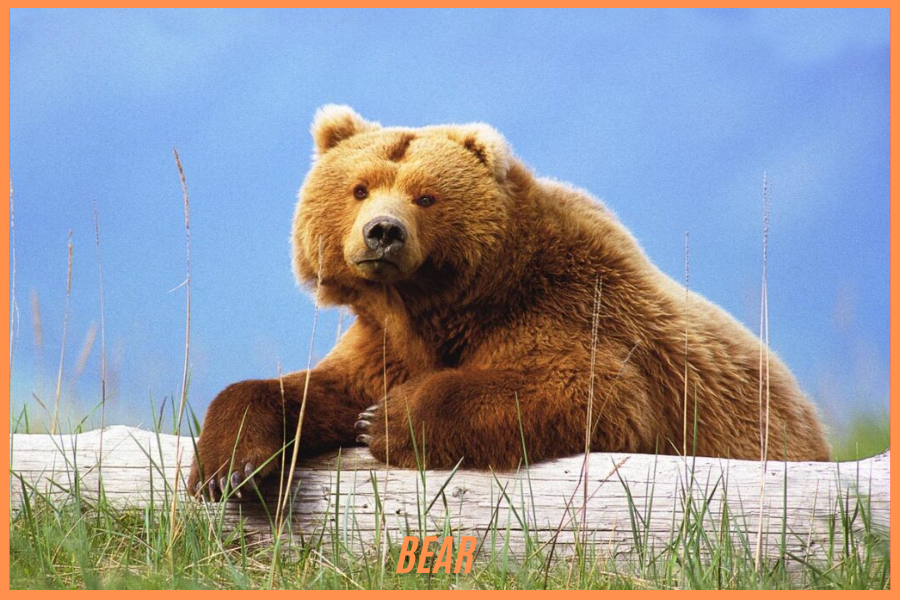Bears, some of the most fascinating creatures on Earth, occupy a wide variety of habitats, from the icy tundras of the Arctic to the tropical forests of Southeast Asia. These formidable animals have captured human imagination for centuries, with their strength, intelligence, and unique behaviors. In this article, we’ll dive deep into the world of bears, looking at their species, physical characteristics, habitats, and conservation efforts to protect them.
The Diversity of Bear Species
There are eight recognized species of bears, each unique in its size, diet, behavior, and habitat. From the towering grizzly to the endangered giant panda, bears are found across the globe in diverse environments.
1. Brown Bear (Ursus arctos)
The brown bear is one of the largest species in the Ursidae family. Found across North America, Europe, and parts of Asia, these bears are typically known for their formidable size and power. Brown bears are most commonly associated with forests, coastal regions, and tundra habitats. The grizzly bear, a subspecies of the brown bear, is particularly notable in North America for its impressive size and strength.
Brown bears are omnivores, consuming a variety of foods, including berries, fish, small mammals, and the occasional large prey. A key behavior of brown bears is their hibernation during winter months. Brown bears enter a state of dormancy during this period, allowing them to survive through the harsh winter when food is scarce.
2. American Black Bear (Ursus americanus)
The American black bear is the most common bear species in North America. These bears have a broad range of habitats, from dense forests to swamps, and can even be found in urban areas. Smaller than the brown bear, black bears are highly adaptable and are often seen foraging for food in human-populated areas, especially in places like national parks.
American black bears are opportunistic feeders, eating anything from fruits, nuts, and insects to small mammals. They are known to be excellent climbers, often ascending trees in search of food or to escape danger.
3. Polar Bear (Ursus maritimus)
Polar bears are a symbol of the Arctic, uniquely adapted to survive in one of the harshest environments on Earth. These bears are marine mammals and primarily rely on sea ice to hunt for their primary food source—seals. They are typically found on the shores of the Arctic Ocean and are known for their white fur, which provides camouflage in their snowy environment.
Polar bears are one of the few bear species that are classified as apex predators in their habitat. Their diet is mainly made up of seals, particularly ringed seals, which they hunt by waiting near breathing holes in the ice.
4. Asian Black Bear (Ursus thibetanus)
Also known as the moon bear due to the white crescent-shaped marking on their chest, the Asian black bear is native to the forests of Asia. This species is found across a wide range of countries, including the Himalayas, Japan, and parts of China. These bears tend to live in mountainous regions, often at higher altitudes, and prefer areas with dense vegetation.
Asian black bears are omnivores, feeding on fruits, nuts, insects, and small vertebrates. They are known to be shy and solitary creatures, though they are also skilled climbers and are often seen foraging in trees.
5. Sloth Bear (Melursus ursinus)
Native to the Indian subcontinent, the sloth bear is a unique species that has a specialized diet. Unlike other bears, sloth bears primarily feed on insects, particularly termites and ants. Their long, curved claws are perfectly suited for digging into termite mounds and ant colonies.
Sloth bears are nocturnal and have a distinctive shaggy coat. They are also known for their loud vocalizations, which they use to communicate with other sloth bears. Despite their somewhat intimidating appearance, sloth bears are not aggressive and are typically shy in nature.
6. Spectacled Bear (Tremarctos ornatus)
The spectacled bear is the only bear species native to South America. Known for the unique markings around their eyes, which give them the appearance of wearing glasses, these bears are primarily found in the Andean mountains of South America. Spectacled bears are the most arboreal of all bear species, spending much of their time in trees, foraging for fruits and plants.
These bears are herbivores, and their diet consists largely of fruits, leaves, and flowers. They are solitary animals and are typically very elusive, making them difficult to study in the wild.
7. Sun Bear (Helarctos malayanus)
The sun bear, the smallest of all bear species, is found in the tropical forests of Southeast Asia. Named for the golden or white patch on their chest, which resembles a rising sun, these bears are excellent climbers. They spend a significant amount of time in trees, where they forage for fruit, insects, and small animals.
Sun bears have a relatively small size compared to other species, but they make up for it with their aggressive nature and incredible strength. They are also known for their long tongues, which they use to extract honey from beehives or termites from nests.
8. Giant Panda (Ailuropoda melanoleuca)
Native to China, the giant panda is one of the most recognizable bear species, thanks to its distinctive black-and-white fur. Unlike other bears, giant pandas primarily feed on bamboo, and they are considered a living symbol of conservation efforts due to their endangered status.
Giant pandas are solitary animals and spend most of their time foraging for bamboo, which makes up over 99% of their diet. Despite their large size, pandas are not aggressive and are generally very peaceful animals.
Wiki
| Species | Scientific Name | Common Name(s) | Habitat | Diet | Notable Features | Conservation Status |
| Brown Bear | Ursus arctos | Grizzly Bear, Kodiak Bear | North America, Europe, Asia | Omnivore (berries, fish, mammals) | Large size, powerful, often hibernates | Least Concern |
| American Black Bear | Ursus americanus | Black Bear | North America (forests, swamps) | Omnivore (fruits, insects, small mammals) | Excellent climber, adaptable | Least Concern |
| Polar Bear | Ursus maritimus | Arctic (sea ice, coastal regions) | Carnivore (seals) | White fur, strong swimmer, marine mammal | Vulnerable |
| Asian Black Bear | Ursus thibetanus | Moon Bear | Asia (forests, mountains) | Omnivore (fruits, nuts, insects) | Crescent-shaped white mark on chest | Vulnerable |
| Sloth Bear | Melursus ursinus | Indian Subcontinent (forests) | Insectivore (termites, ants) | Long claws, nocturnal, shaggy coat | Vulnerable |
| Spectacled Bear | Tremarctos ornatus | Andean Bear | South America (Andes mountains) | Herbivore (fruits, leaves) | Distinctive facial markings, arboreal | Vulnerable |
| Sun Bear | Helarctos malayanus | Southeast Asia (tropical forests) | Omnivore (fruits, insects, small animals) | Smallest bear, long tongue, excellent climber | Vulnerable |
| Giant Panda | Ailuropoda melanoleuca | China (bamboo forests) | Herbivore (bamboo) | Black-and-white fur, primarily bamboo diet | Vulnerable |
Physical Characteristics of Bears
Bears are large, powerful animals, but their size and physical traits vary significantly between species. The average bear has a robust build, with a strong skeletal structure and powerful limbs, which help them climb, dig, and run. However, their body size, fur, and other characteristics are adapted to their environments and lifestyles.
Size and Weight
Bears can range from relatively small to enormous. For example, the sun bear is only about 1.2 meters long and weighs between 25 and 65 kg, while the Kodiak bear can grow up to 3 meters long and weigh more than 700 kg. Bears like the brown bear and the polar bear are known for their massive size, which helps them survive in their cold and challenging environments.
Fur and Coloration
Bears are covered in thick fur that helps them stay warm, particularly species like the polar bear. Their fur can range in color from the black fur of the black bear to the white fur of the polar bear. In between, there are many shades of brown and even red, as seen in the sun bear and sloth bear.
Claws and Teeth
Bears have strong, sharp claws that are essential for digging, climbing, and capturing prey. Their claws are also used to mark territory and communicate with other bears. Similarly, their teeth are adapted for their omnivorous diets. Bears have large, sharp teeth, including carnassials for shearing meat and molars for grinding plant material.
Senses
Bears have an exceptional sense of smell, which is key to their survival. They rely heavily on their noses to find food, navigate their environment, and detect potential threats. Their eyesight is not as developed as their sense of smell, but many species have excellent hearing, helping them detect danger.
Behavior and Social Structure
Bears are generally solitary animals, with some exceptions like the giant panda, which occasionally shares a habitat. Most species live alone, except during mating season or a mother with her cubs.
Feeding and Foraging
Bears are omnivores and scavengers, with a varied diet that includes fruits, nuts, insects, and small mammals. Some species, like the polar bear, are more carnivorous, relying heavily on seals as their primary food source.
Bears often use their acute sense of smell to find food. They will forage over large areas in search of berries, roots, and insects. In the case of grizzly and brown bears, they also hunt for fish, particularly during salmon spawning seasons.
Hibernation
Many bear species hibernate during the winter months, a survival strategy that helps them weather the harsh conditions of cold climates. Hibernation is not the same as true hibernation in some mammals; bears enter a state called torpor, where their metabolism slows down, and they are able to survive for months without food.
During this time, bears will not eat, drink, urinate, or defecate. They will rely on the fat reserves they’ve built up during the warmer months to sustain them.
Communication
Bears communicate through body language, vocalizations, and scent marking. They use vocalizations like growls, roars, and grunts to communicate with each other, especially when it comes to mating or territorial disputes. They also use scent marking to establish dominance or warn other bears of their presence.
Conclusion
Bears are truly remarkable creatures, each species offering unique traits and behaviors that make them stand out in the animal kingdom. Whether it’s the mighty polar bear in the frozen Arctic or the elusive sun bear in the tropical forests of Southeast Asia, each type of bear plays a crucial role in its respective ecosystem. From their diverse diets and habitats to their fascinating social structures and survival strategies, bears continue to captivate and inspire people around the world.
Understanding these majestic creatures helps us appreciate their importance in maintaining the balance of nature. While many bear species face threats from habitat loss, climate change, and poaching, efforts to protect and conserve them are more vital than ever. By supporting conservation initiatives and fostering a deeper respect for wildlife, we can ensure that future generations will continue to witness the beauty and majesty of bears in the wild.
FAQs
1. What are the different types of bears?
There are eight species of bears, which include the brown bear, American black bear, polar bear, Asian black bear, sloth bear, spectacled bear, sun bear, and giant panda. Each species has unique characteristics and habitat preferences, ranging from cold Arctic regions to tropical forests.
2. What do bears eat?
Bears are omnivores, meaning they eat both plants and animals. Their diet can include fruits, berries, nuts, fish, small mammals, insects, and even larger animals. The exact diet varies depending on the species and the environment in which they live.
3. How big can bears get?
Bears can vary significantly in size. The largest species, the Kodiak and polar bears, can weigh up to 700 kg (1,500 pounds) and grow to lengths of over 3 meters (10 feet). Smaller species, like the sun bear, weigh as little as 25-65 kg (55-143 pounds).
4. Where do bears live?
Bears are found on every continent except Antarctica. They live in a variety of habitats, including forests, mountains, tundra, and even coastal regions. Some species, like the polar bear, are specifically adapted to cold, icy environments, while others, like the sun bear, thrive in tropical forests.
5. Do bears hibernate?
Many bear species, particularly those living in colder climates, enter a period of hibernation during the winter months. However, bear hibernation is not the same as true hibernation. Bears enter a state of torpor, where their metabolic rate slows down significantly, allowing them to survive for months without food, water, or waste elimination.
6. Are bears dangerous to humans?
While bears are generally not aggressive toward humans, they can be dangerous if they feel threatened or cornered, particularly mothers protecting their cubs. It’s important to respect bears in the wild and avoid approaching them. Most bear encounters can be avoided by following proper safety guidelines when hiking or camping in bear habitats.
7. What can we do to protect bears?
Conservation efforts to protect bears include preserving their natural habitats, enforcing anti-poaching laws, and supporting research on bear populations. Additionally, raising awareness about the threats bears face, such as habitat destruction and climate change, is crucial in the effort to ensure their survival for future generations.
Unlock the latest news and updates on Magazine Format




